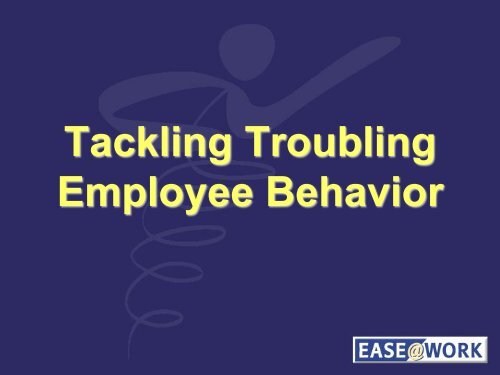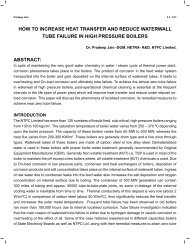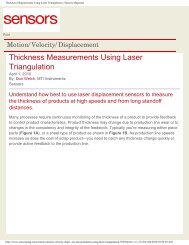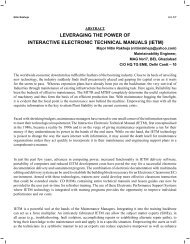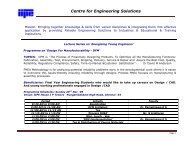Tackling Troubling Employee Behavior
Tackling Troubling Employee Behavior
Tackling Troubling Employee Behavior
Create successful ePaper yourself
Turn your PDF publications into a flip-book with our unique Google optimized e-Paper software.
<strong>Tackling</strong> <strong>Troubling</strong><br />
<strong>Employee</strong> <strong>Behavior</strong>
EMOTION<br />
e·mo·tion<br />
A mental state that arises<br />
spontaneously rather than through<br />
conscious effort and is often<br />
accompanied by physiological<br />
changes; a feeling: the emotions of<br />
joy, sorrow, reverence, hate, and<br />
love.
How might you rate your<br />
emotional stability?<br />
1. My emotions are stable<br />
2. My emotions tend to be stable<br />
3. Don’t know<br />
4. I occasionally feel unstable and have mood<br />
swings<br />
5. I have frequent and significant emotion/mood<br />
swings<br />
• Now think about those in your workplace who<br />
may answer this as a 4 or 5<br />
*http://www.diagnose-me.com/questionnaire/Q2835.html
How does heightened emotion on the<br />
job affect the workplace?<br />
Damages morale<br />
Lessens cooperation<br />
Increases worker conflict<br />
Increases absenteeism<br />
Decreases productivity<br />
Deflects focus from the job<br />
Increases employee turnover<br />
Impairs judgment and reaction times, therefore raising<br />
the risk of errors and accidents
Emotion Principles<br />
• Our emotional responses are learned, usually<br />
patterned.<br />
• Involves mental conversations that deal with<br />
contradictions to our beliefs and expectations.<br />
• Negative emotions, such as anger, are internally<br />
created and thus can be internally managed.<br />
• Our feelings are most often expressed to those<br />
that are meaningful to us.
Plutchik’s Wheel of Emotions
The Emotion Effect<br />
If left unresolved or unaddressed, a primary<br />
emotion can lead to a secondary emotion,<br />
and ultimately to a tertiary emotion.<br />
Example: Anger > Rage > Hostility<br />
Sadness > Neglect > Alienation<br />
Fear > Horror > Panic
Troubled<br />
trou·bled<br />
Disturbed, worried, distressed,<br />
agitated.
Why might your employee be<br />
troubled…<br />
• Are they displeased with the<br />
outcome of a situation?<br />
• Were expectations unmet?<br />
• Was there a misunderstanding?<br />
• Do they feel things are out of<br />
their control?<br />
• Do they feel mistreated?<br />
• Are they creating their own<br />
internal stress?
Can they control/stabilize their mood and<br />
actions?
From Expectations to Responses<br />
EMOTION<br />
Primary Feeling<br />
Mental Conversion<br />
<strong>Behavior</strong>al Response<br />
Situation<br />
Expectation
Warning Signs:<br />
•Obsessive involvement or emotional<br />
attachment to the job<br />
•Prone to making direct or indirect threats<br />
•Aggressive, anti-social behavior<br />
•Overreaction to work policies or<br />
performance appraisals<br />
•Inconsistent or apathetic work performance<br />
•Stressed relationships with co-workers<br />
•Frequently irritable, moody or sarcastic<br />
behavior
Keep in mind…<br />
Persistent or excessively irritable,<br />
angry behavior may be a symptom of a<br />
larger psychological problem –<br />
such as:<br />
Addiction<br />
Post-traumatic stress disorder<br />
Depression
Common causes of<br />
supervisor/employee conflict:<br />
• Poor communication<br />
• Disrespect/undermining authority<br />
• Betrayal of trust<br />
• Excessive negative feedback from manager<br />
• Unreasonable demands made by managers<br />
• General harassment – sexual, bullying<br />
• Failure of a manager to take disciplinary action<br />
when needed<br />
• Micromanaged environment with little<br />
opportunity for decision making
DEFENSE OR TRAP DESCRIPTION OR EXAMPLE COUNTER MOVE<br />
Excuses & Sympathy<br />
Problems<br />
<strong>Employee</strong>s will have a good reason for everything that happens.<br />
“You’d have the same troubles I do if you had a family like mine.”<br />
“You may have problems at home. I am<br />
concerned about your performance and my<br />
data here says you are not doing your job. ”<br />
Apology & Promises “I’m really sorry. You know that I’ll never do it that way again.” “I appreciate your apology. But what you did is<br />
serious. I need to file a deficiency report.”<br />
Switching<br />
“I know about that, but look what a good job I’ve done on that Harris<br />
job!”<br />
“You did do well on Harris. I want good work<br />
on all jobs. You have had more problems than<br />
success lately. Look at the record.”<br />
Anger<br />
“Damn it! One mistake and the roof falls in – after 15 years of killing<br />
myself for this place.”<br />
“I expect you to listen to me. Just getting<br />
angry won’t help anyone, especially you. I’m<br />
concerned about your performance. And I’m<br />
not talking about one mistake. Look at the<br />
record.”<br />
Tears “I don’t know what to do. I’ll never get out of this mess.” (Cryin “I appreciate your feelings. I want you to know<br />
that I want to help, which is why I set up this<br />
meeting. You have been a valuable part of our<br />
organization. I want to tell you about our<br />
<strong>Employee</strong> Assistance Program.”<br />
Self Pity<br />
Innocence & Blaming<br />
Friendliness & Deduction<br />
“I knew this would happen. I’ve never been able to do anything<br />
right.”<br />
“It’s not my fault. Joe let me down. I don’t get any help at all around<br />
here.”<br />
“Now, you know we’ve been through this before and we worked it out<br />
together. Let’s get together after work and figure this out where we<br />
can be more comfortable. ”<br />
“I wouldn’t be taking the time to talk with you if<br />
I didn’t have faith in you. So let’s move on to<br />
talk about what can be done to help. You<br />
know our <strong>Employee</strong> Assistance Program could<br />
help.”<br />
“I’ve checked into this in detail (points to<br />
record). We need to start with what we can<br />
do.”<br />
“I know we’ve been through this before, and<br />
this time things will be different. I am filing a<br />
report because I’ve done all I can do to work<br />
this out on the job. I think something is wrong<br />
and I want you to see the EAP.”<br />
Hopelessness “I may as well quit right now.” “You may have done excellent work. I<br />
want more of that from your department<br />
which is why I set up this meeting.”
When is an <strong>Employee</strong> Considered<br />
High Risk?<br />
• It is advisable to seek consultation from <strong>Employee</strong><br />
Relations immediately when you have knowledge of<br />
employees presenting with the following traits or<br />
behaviors, especially more than one:<br />
• Known history of violence<br />
• Preoccupation with violence or weapons (or owns<br />
weapons)<br />
• Threats with intent to harm self, others, and property<br />
• Defiant/ demanding/intimidating behavior<br />
• Frequent disruptive behavior in the workplace<br />
• Mood swings
How to Counsel Troubled<br />
<strong>Employee</strong><br />
Step 1:<br />
Take note of dramatic changes in the employee's<br />
performance and on-the-job behavior.<br />
• Adequate documentation will assist you in evaluating job<br />
performance and confronting an employee when<br />
necessary.<br />
– Documentation should be:<br />
• Specific<br />
• Objective<br />
• Factual<br />
• Thorough<br />
• Timely
What to look for and document in<br />
job performance:<br />
1. Absenteeism (Most Obvious)<br />
– Frequent unscheduled short-term absences (with or<br />
without medical explanation)<br />
– Frequent use of unscheduled vacation time.<br />
2. “On the Job” Absenteeism<br />
– At work but productivity and efficiency lacking<br />
– Continued absence from job location more than job<br />
requires<br />
– Frequent trips to water fountain or restroom<br />
– Long breaks.
What to look for and document in<br />
job performance:<br />
3. Accidents<br />
• Physical complaints on the job<br />
• Accidents on and off the job<br />
4. Observed Changes in Work Pattern<br />
• General absentmindedness, forgetfulness<br />
• Alternative periods of high and low productivity<br />
• Coming to work intoxicated<br />
• Missed deadlines<br />
• Inability to perform tasks they were able to do in the past
What to look for and document in<br />
job performance:<br />
4. Observed Changes in Work Pattern (Cont.)<br />
• Mistakes due to poor judgment<br />
• Outside complaints about the employee’s work<br />
• Improbable excuses for these poor patterns<br />
• Carelessness<br />
5. <strong>Employee</strong> Relationships on The Job<br />
• Overreaction to real or imagined criticism<br />
• Borrowing money from co-workers<br />
• Repeated and compulsive criticism of Department or<br />
University
What to look for and document in<br />
job performance:<br />
6. <strong>Employee</strong> Relationships on The Job<br />
(cont.)<br />
• Unrealistic expectations for promotion<br />
• Abrasiveness with others (managers and coworkers)<br />
7. Work Relationships in the University<br />
Community<br />
• Inappropriate behaviors<br />
• Complaints from other departments or customers
What to look for and document in<br />
job performance:<br />
8. Changes In <strong>Employee</strong>’s <strong>Behavior</strong><br />
Appearance<br />
– Sloppy<br />
– Inappropriate clothing<br />
– Mood<br />
– Withdrawn<br />
– Sad<br />
– Mood swings (high and low)<br />
– Suspiciousness<br />
– Extreme sensitivity<br />
– Frequent irritability
How to Counsel Troubled<br />
<strong>Employee</strong> Continued…<br />
• Step 2:<br />
Meet with the employee and determine whether<br />
the problem is personal or job-related.<br />
• Step 3:<br />
Avoid becoming involved in an employee's<br />
personal problem. If the employee needs<br />
professional help (including anger management),<br />
put him or her in touch with <strong>Employee</strong> Relations<br />
or EASE.
How to Counsel Troubled<br />
<strong>Employee</strong>s Continued…<br />
• Step 4:<br />
Focus on performance issues if the trouble is jobrelated.<br />
In a calm, non-accusatory manner, point out<br />
the changes in the employee's performance.<br />
• Step 5:<br />
Ask what you can do to help.<br />
• Step 6:<br />
Work with the employee to develop concrete goals<br />
and a timeline for resolving the performance issues.<br />
– Do establish the levels of work performance you<br />
expect. Set the limits that you will tolerate.<br />
– Determine what is acceptable and unacceptable to<br />
you.<br />
– Be consistent. Treat all employees equally.
How to Counsel Troubled<br />
<strong>Employee</strong>s Continued…<br />
• Step 7<br />
• If the person shows behavior that poses a direct threat to<br />
themselves or others (including physically being unable<br />
to perform at work safely), call <strong>Employee</strong> Relations<br />
and/or Security immediately. A condition of employment<br />
or mandatory referral can be made that requires the<br />
person to be evaluated by a mental health professional<br />
via EASE or outside EASE and recommendations made<br />
as to whether the individual can safely and effectively<br />
perform in the job. They would be on a suspension<br />
during this period to give them time to provide<br />
documentation from their physician. Once we receive<br />
documentation, they can be placed on a leave.<br />
• Important: If you feel threatened, you should suspend<br />
immediately and deactivate the employee’s accesses.
How to Counsel Troubled<br />
<strong>Employee</strong>s Continued…<br />
If you suspect an employee is under the influence<br />
Step 1:<br />
Take note of dramatic changes in the employee's performance<br />
and on-the-job behavior.<br />
• Adequate documentation will assist you in evaluating job<br />
performance and confronting an employee when necessary.<br />
– Documentation should be:<br />
• Specific<br />
• Objective<br />
• Factual<br />
• Thorough<br />
• Timely
How to Counsel Troubled<br />
<strong>Employee</strong>s Continued…<br />
Observations may include:<br />
• Odors (smell of alcohol, body odor or urine)<br />
• Movement (unsteady, fidgety, dizzy)<br />
• Eyes (dilated, constricted, watery, involuntary eye<br />
movements)<br />
• Face (flushed, sweating, confused)<br />
• Speech (slurred, slow, distracted mid-thought)<br />
• Emotions (argumentative, agitated, irritable)<br />
• Change in performance (errors, failure to follow through,<br />
inability to multi-task)
How to Counsel Troubled<br />
<strong>Employee</strong>s Continued…<br />
Step 2:<br />
‣ Contact <strong>Employee</strong> Relations (ER) immediately for advice and<br />
guidance.<br />
‣ In consultation with ER, prepare the Positive Corrective Action form<br />
placing the employee on an investigatory suspension.<br />
‣ Schedule the suspension meeting with the employee and ER<br />
representative or another supervisor, if an ER representative is not<br />
available, as soon as possible.<br />
‣ During meeting, recap previous meetings and refer to<br />
documentation of observed behaviors or performance issues.
How to Counsel Troubled<br />
<strong>Employee</strong>s Continued…<br />
‣ A mandatory management referral will be made to the<br />
<strong>Employee</strong> Assistance Program, EASE.<br />
‣ EASE will determine if a treatment program is<br />
necessary.<br />
‣ The employee will be placed on an investigatory<br />
suspension until documentation from a Health Care<br />
Provider is submitted. At that time, the employee will be<br />
on a personal medical leave.
Summary of Supervisory Guidelines<br />
Focus on behavior<br />
• Observe<br />
• Document<br />
Confront and Support the <strong>Employee</strong><br />
• Don’t diagnose<br />
• Use documentation<br />
Follow Through<br />
• Monitor and document<br />
• Be consistent
<strong>Employee</strong> Assistance Program<br />
(EASE)<br />
• Assists troubled employees in handling personal and/or<br />
health related problems that adversely affect job<br />
performance and productivity.<br />
• Supervisors are responsible for considering EASE as an<br />
option for an employee whose work performance or<br />
behavior/conduct is not meeting standards or could<br />
warrant corrective action.<br />
• Supervisors must contact <strong>Employee</strong> Relations or Human<br />
Resources Administrator before taking action when work<br />
performance issues occur and/or corrective action is<br />
warranted.
Case Studies<br />
• Joe <strong>Employee</strong> (JE) seemed really angry when he came into work;<br />
he slammed doors and was extremely gruff with several coworkers.<br />
Although what he was saying couldn’t be clearly<br />
understood, JE was observed talking to himself in an aggravated<br />
manner. What should JE’s manager do?<br />
• For the past two weeks, Sydney <strong>Employee</strong> (SE) has refrained<br />
from joining her team’s internal meetings as well as her<br />
extracurricular work softball team games. She avoids<br />
conversation and has been withdrawn. When approached, she<br />
“doesn’t feel like talking.” Her work assignments have shown lack<br />
of effort. What should SE’s manager do?<br />
• Kathy <strong>Employee</strong> (KE) has been voicing concerns to her manager<br />
that she fears she’s being followed at work and at home and that<br />
her phone line is tapped. What should KE’s manager do?
The EAP Can Help!<br />
Anything from anger management to EFT<br />
techniques to conflict coaching, to<br />
management skill-building…the EAP can<br />
improve productivity and profits, help build<br />
relationships and repair them, and<br />
enhance employee morale.
USE YOUR RESOURCES<br />
You can benefit from the EAP’s services:<br />
• Consultation<br />
• Assessment and Referral<br />
• Case Monitoring


